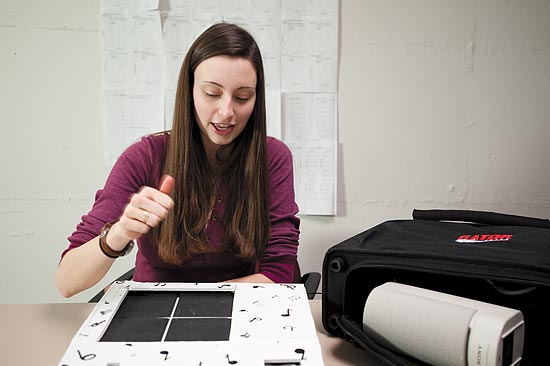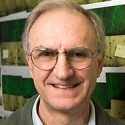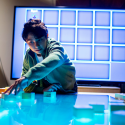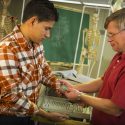Curiosity blossoms into graduate career
Although they shared the same diagnosis, the autistic children Lynn Gilbertson came to know during high school were each unique. Her friend’s 3-year-old brother loved cars and identified everyone by their vehicles (Gilbertson was the Chevy Prizm). A boy she cared for at a volunteer job sang “Row, Row, Row Your Boat” when troubled and grew calmer when Gilbertson joined in.
And then there was the little girl with a gift for art, who, instead of drawing outlines for her pictures, made shapes and put them together to create the whole.
“Basically she made mosaics,” says Gilbertson, who grew up in West Salem near La Crosse. “And she was four years old.”
Gilbertson found the kids utterly charming, but she also saw the strain that their struggles with language, lack of sociability and other traits placed on their caretakers. It stirred in her a deep curiosity about autism spectrum disorder, a condition that one in 150 U.S. children now have, according to the Centers for Disease Control and Prevention. What exactly do these kids experience? Why do they behave the way they do? And could a better understanding of their world bring relief to families?
“I think part of the problem when families hear a child has autism is that they don’t know how they’re going to interact with that child,” Gilbertson says. “So helping to bridge that gap could be comforting to the family, I think, and reduce the stress for the child.”
Now a first-year Ph.D. student in communicative disorders, Gilbertson has wasted no time pursuing those questions. As an undergraduate in the same department, she dove boldly into the scientific literature and sought out anyone on campus, including autism researchers Morton Gernsbacher and Susan Ellis Weismer, who could further her knowledge. She has submitted her first research paper on hearing in autistic toddlers for publication. And she’s already plotting a second study with her graduate adviser, communicative disorders professor Bob Lutfi.
Lutfi says he has been greatly impressed by his young student’s maturity as a scholar, but Gilbertson downplays the notion that her dedication is unusual.
“If you’re interested in something, you’re more than willing to spend time learning about it,” she says. “I’m just lucky to have found a topic that I’m really passionate about.”
Even so, upon arriving at UW–Madison in 2004, Gilbertson originally planned to study law and become an adoption attorney. That all changed, though, when she took her first course in communicative disorders. Taught by Lutfi, an expert in auditory perception, the class included several lectures on hearing and Gilbertson was hooked. Soon afterward, she declared communicative disorders as her major and began seeking out her professors after class.
In Lutfi’s case, the discussions started over a weird computing glitch that handed Gilbertson an “F” on every exam. (“It was an interesting mishap,” she laughs. “I don’t know if he remembers.”) But soon enough, the conversation turned to autism in children, and especially their listening preferences. Eventually, Gilbertson learned about the Hilldale Undergraduate Research Fellowships program, and she and Lutfi put in a proposal that ended up funding her first study.
What she aimed to discover was whether autistic children preferred listening to “nonsocial,” mechanical noises, such as a beeping timer, or to social sounds, especially the lilting “prosodic” speech, or baby talk, that parents frequently use with their kids. The scientific literature suggested children with autism favored the former, leading some to argue for using mechanized sounds in computer programs to teach them language rather than regular speech.
But Gilbertson and Lutfi took issue with this research because it relied on the “head turn” method, a technique that assumes a child likes a sound the longer and more often he turns toward it, as judged by an observer. The trouble is, autistic kids may not exhibit this reflex at all, says Gilbertson, since their responses to environmental stimuli are often atypical anyway.
More importantly, children will turn toward a sound for many reasons besides liking it, including being startled, curious or even annoyed, she says. “So we tried to eliminate that ambiguity in the measurement to make sure we were getting at preference.”
The technique they devised involved a game with four keypads. Each, when pressed, played one of four sound types: bubbly, prosodic speech; monotone speech; a prosodic mechanical sound, such as a chiming cuckoo clock; and a monotone mechanized sound, such as a beeper. The idea was that the more a child liked a certain sound, the more she would press its key to hear it.
Earlier studies predicted that autistic kids would press the pads for the mechanical noises more often than would children with normal development. But after testing 15 toddlers with autism from Weismer’s and Gernsbacher’s Toddler Talk project at the Waisman Center and 14 control kids, the researchers found no difference. Both groups preferred the bubbly speech sounds to everything else.
The findings are still in review, and Gilbertson cautions that they need to be repeated with a larger group of children. But she also hopes they encourage parents of autistic children to keep talking to them as they would to any child, even when there’s little response. In other words, when it comes to the sounds they like to hear, perhaps autistic kids aren’t so unique after all.
“I think autism tells us to embrace our differences,” says Gilbertson. “But at the same time, the results show we have much more in common than we think.”





